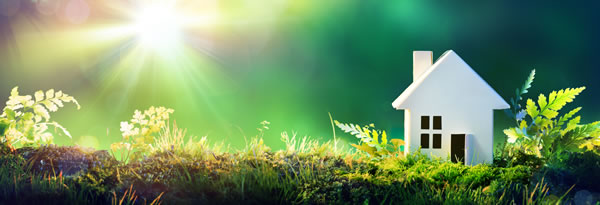By Guest Blogger
Damon Henrikson
Did you ever think you’d see the day when “green” was mainstream? We may not be there quite yet, but we’re getting close. By 2018, 84 percent of U.S. building firms expect to include green features in over 15 percent of their projects. And of course, in certain regions that percentage is far higher.

This is heartening news. Whether you’re looking at remodeling your home or building a new one, you should be able to find a contractor that understands your needs and delivers. Now, it’s time to get down to the fun part — exploring the possibilities of green design! Let’s take a look at some of the more interesting green trends showing up in today’s green home designs.
5 Sustainable Home Design Trends
- Tubular skylights. Lighting accounts for 14 percent of the electricity budget of the average home. How much greener to simply use free light coming from above? In contrast to traditional skylights, which require major roof construction, tubular skylights can be easily installed in a matter of an hour or two. These ingenious devices use multiple lenses to funnel sunlight through a reflective tube, and then disperse it into your living space. The result? An abundance of pleasant, natural daylight with minimal impact to the structure of your home.
- Graywater systems. One environmental issue you can expect to hear more and more about in the coming decades is water conservation. Already, many states and municipalities are passing mandates to restrict municipal water use. This is great news for the environment, but if you love a lush garden, it may require some adjustment, especially if you live in an arid area. One way around water restrictions is to recycle your household graywater — the leftover water from your bathroom sink, shower and/or washing machine. This water is safe to use in the landscape and is nourishing to plants. Graywater can also be used indoors to flush toilets, which can substantially reduce household water use. Graywater systems are not allowed in every municipality and may have to conform to code, so do your homework before installing one.
- Native landscaping. The desire to conserve water is also causing many people to re-think their lawns. Turf is one of the most water-intensive landscape options. A lovely alternative to turf is to replace it with native plants from your region. Native plants require little to no irrigation, and they offer food and shelter to native species of birds and other wildlife. You can even choose edible species — such as the serviceberry and pawpaw — that will provide local, sustainably grown delicacies for your own table.
- Reclaimed wood floors. Hardwood floors will never go out of style. Plus, wood is a renewable resource that, if managed properly, is highly sustainable. However, you can take it a step further by selecting reclaimed wood for your floor. This is wood that has been used before, usually as part of a barn or old warehouse. Using it again has many benefits: It saves energy, preserves our forests, and keeps the material out of the landfill. Reclaimed wood is one of the few ways you can enjoy the beauty of old growth lumber without marring your conscience. What’s more, you will enjoy explaining to your guests the history embedded in your home. In addition to flooring, reclaimed wood is popular for use as siding and cabinetry.
- Perforated metal accents. If you don’t think of metal as green, think again. Metal is easily recycled, promotes clean indoor air, and is highly durable, which means its embodied energy over the lifetime of your home is typically very low. It’s also easy to find recycled metal materials. Perforated metal is especially sustainable because it has extremely high structural strength for a very small amount of material. There are so many uses for perforated metal! Try a decorative metal screen to divide a large indoor room or provide shade from the afternoon sun. How about a steel grid stairway for a sleek, modern look? Or, consider training vines up a perforated metal panel for a truly “green” accent.
Of course, these suggestions are just the tip of the iceberg. There are many more outstanding green home design options just waiting to be explored. What will you discover next? Whichever ideas you decide on, they are sure to improve your enjoyment of and pride in your home just as much as they do your environmental footprint.
Author bio: Damon Henrikson is the Director of Marketing at Accurate Perforating Company in Chicago, Illinois. Accurate Perforating produces a variety of metal products for commercial use. Henrikson brings over 10 years of experience in the manufacturing space and over five years of experience specifically within the perforated metal industry.